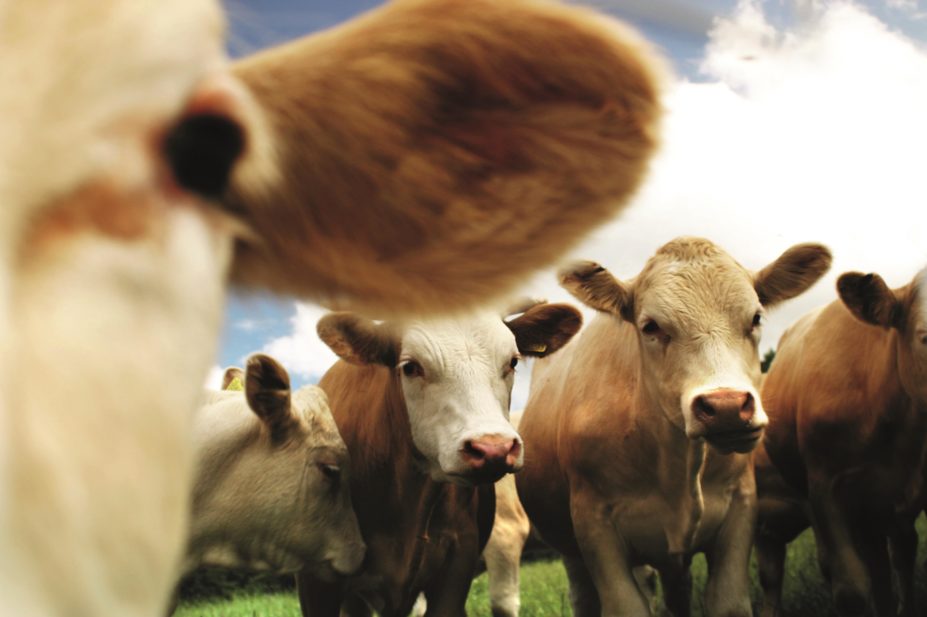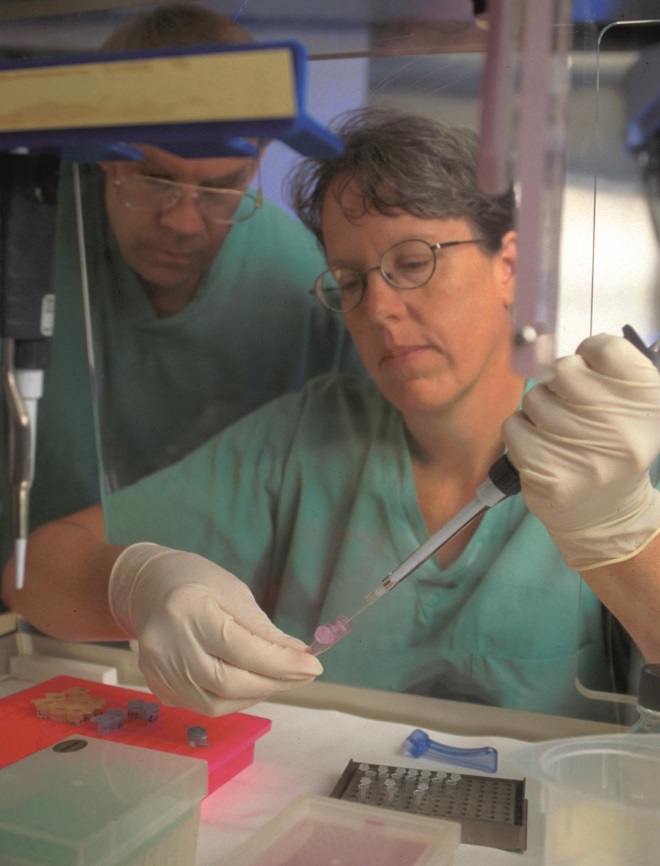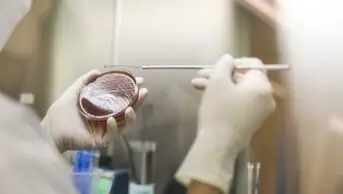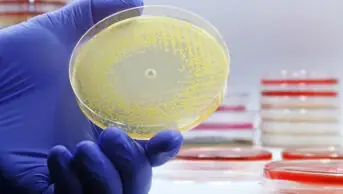
Blackout Concepts / Alamy
Imagine a farm with over 100,000 head of cattle, each one receiving daily low-dose antibiotics in their food or water, not to treat illness, but to make them put on weight faster.
In the United States, the total amount of antibiotics used in food-producing animals rose by 16% between 2009 and 2012, to 14.61 million kilograms per year, and there is a great deal of overlap between the drugs used in animals and those used in humans. The most recent data on human use in the United States, from 2011, shows that Americans used 3.5 million kilograms of antibiotics that year[1]
.
What’s more, 97% of those drugs are sold over-the-counter, without a veterinarian seeing the animals or writing a prescription. And 94% are intended to be given to an entire flock or herd in feed or water, indicating they are being used for disease prevention or growth promotion, rather than to treat sick animals. Such blanket use, often at subclinical doses, has a real potential to create resistance because it wipes out the weaker bacteria leaving the playing field open for the strongest, most resistant ones to thrive.
In Europe, an estimated 25,000 people die each year after becoming infected with antibiotic-resistant bacteria. And in the United States, this figure is at least 23,000.
There probably won’t be another silver bullet like antibiotics
Globally, an estimated 480,000 people developed multidrug-resistant tuberculosis in 2013 and resistance to the treatments of last resort for the sexually transmitted disease gonorrhoea has been detected in ten countries.
The irresponsible use of antibiotics in humans is a far greater contributor to antimicrobial resistance than their use in animals. However, there is a broad variety of new technologies under development that could help to reduce or replace the use of antibiotics in animals.
“There probably won’t be another silver bullet like antibiotics,” says Cyril Gay, a senior national program leader for the US Department of Agriculture (USDA) agricultural research service. “But if we have several alternatives and we understand how they work, we can use them more selectively.”
Taking notice
After several years of dire warnings about entering the “post-antibiotic era”, world leaders are starting to take notice, and researchers are racing to develop new drugs or alternative ways to treat and prevent disease.
In September 2013, the UK government released its five-year plan for dealing with antimicrobial resistance, which involves efforts to conserve the effectiveness of current drugs and stimulate the development of new ones[2]
. And in July 2014, Prime Minister David Cameron asked economist Jim O’Neill to lead an international commission to determine why no novel drugs have emerged in recent years.
Nesta, an independent innovation charity in the UK, announced in June 2014, after a public vote, that its £10m Longitude Prize will focus on fighting antibiotic resistance. It is seeking ideas for cheap, easy tests to diagnose bacterial infections so that doctors know whether antibiotics are appropriate, and even which ones might be most effective.
The United States government released a national strategy in September 2014 that treats the problem as an issue of national security[3]
. President Barack Obama has created a task force, led by the secretaries of defence, agriculture, and health and human services, that is charged with developing a five-year action plan to implement the strategy by February 2015.
And the World Health Organization (WHO) declared antimicrobial resistance to be a global threat in its first surveillance report[4]
on the subject in April 2014. The following month, the organisation committed to developing a draft global action plan by May 2015.
Keeping ahead
Resistance to antimicrobial drugs is a natural phenomenon. As bacteria and other microbes are exposed to antibiotics, they will eventually develop resistance through random mutations and by transferring resistance genes among themselves. The trick is for humans to keep one step ahead by continually developing new drugs and by making careful use of the ones already available.
The problem is, pharmaceutical companies haven’t been doing a very good job on the first part of that equation with few new classes of antibiotics reaching the market since the 1960s. But, perhaps more importantly, others have been doing a poor job of protecting the drugs we already have.
Resistance can arise through the overuse, or improper use, of antibiotics in both humans and animals. On the animal side, the concern centres around antibiotics being given to entire herds either to prevent disease or to promote growth. In half of the countries in the world, including the United States and Canada, antibiotics are still used as growth promoters.
In North America, there are very few regulations on antibiotic use in agriculture. However, the US Food and Drug Administration produced guidance in 2012 on the “judicious use” of antimicrobials in the rearing of animals for food production[5]
. If this guidance is followed, then a gradual phasing out of the use of antibiotics as growth promoters can be expected.
In Europe, antibiotic use in animals is much more tightly regulated and several European countries have set strict limits on antibiotic use in agriculture, and strong annual targets to reduce the amount used. In 1971, the UK withdrew authorisation for use of several substances as growth promoters, including tetracyclines and penicillin. Other countries followed suit and a comprehensive ban on the use of all antibiotics as growth promoters was eventually introduced in the EU in 2006.
Rational use of antibiotics in animals is part of the European Commission’s action plan against antimicrobial resistance, and the European Medicines Agency (EMA) announced[6]
in October 2014 that sales of antibiotics for use in animals had fallen overall by 15% between 2010 and 2012.
Transferring resistance
Resistance that arises in animals could affect humans in two ways. Food-borne pathogens could develop their resistance in animals before going on to infect people via the food supply. Or resistance genes could be transferred from animal bacteria to human pathogens through a process known as horizontal gene transfer, where genetic material is swapped between neighbouring bacteria. This transfer occurs via three mechanisms: transformation, transduction and conjugation (see ‘On the move’).
If you put antibiotics into animals it can lead to resistance, and it’s possible for that resistant bacteria to transfer to humans
Transformation involves the uptake of naked DNA by competent bacterial cells, transduction involves the transfer of genetic material via bacteriophages, and conjugation involves transfer of DNA via sexual pilus and requires cell-to-cell contact.
John Fitzgerald, secretary general of Responsible Use of Medicines in Agriculture Alliance (RUMA), a UK industry body of which the Royal Pharmaceutical Society is a member, acknowledges that agricultural use of antibiotics is part of the problem of antimicrobial resistance. “If you put antibiotics into animals it can lead to resistance, and it’s possible for that resistant bacteria to transfer to humans,” he says.
However, he adds that, on balance, the contribution to resistance from the use of antibiotics in agriculture is small compared with that from irresponsible use in humans. “But we need to make sure that risk is as small as possible,” he says.
The World Organization for Animal Health (OIE), an intergovernmental organisation responsible for improving animal health worldwide, backs Fitzgerald’s assessment. “For antimicrobial resistance, animals are not the biggest piece of the puzzle; the major problem is on the human side,” says Catherine Bertrand-Ferrandis, OIE’s head of communications.
Animals are not entirely without blame though. In particular, resistant strains of Campylobacter and Salmonella bacteria involved in human disease primarily come from farm animals, according to the European Food Safety Authority.
More recently, emerging evidence has shown that Staphylococcus aureus (including meticillin-resistant Staphylococcus aureus) and Clostridium difficile also occur in food animals and can later be found in food products and environments shared with humans[7]
.
The OIE publishes a list of antimicrobials that are critically important in animal health[8]
, which complements a similar list for human health produced by WHO[9]
. In its most recent list, published in 2011, WHO has included veterinary drugs that fall into the same classes as those in the human medicine list, so that veterinary medicines analogous to human medicines — which have a greater potential to impact resistance — can be readily identified.
WHO says that carbapenems, lipopeptides and oxazolidinones have no veterinary equivalent and recommends that these classes, as well as any new class of antimicrobial developed for human therapy, should not be used in animals, plants, or in aquaculture.
Both RUMA and the OIE advocate the responsible use of antibiotics by trained professionals, as well as vaccination and good hygiene practices to limit the spread of resistance from animals to humans.
But measures like these can only slow the development of resistance, not stop it altogether. For that, new drugs and treatments will be needed.
Fitzgerald explains that the economic incentive for new animal products is not as great as that for humans, so many animal medicines come from human medical research.
However, researchers are looking everywhere for new ideas for ways to fight bacteria, both to treat or prevent disease, and to replace the use of antibiotics as growth promoters. Examples include enzymes derived from bacteriophage viruses, antimicrobial proteins found in animals, antibodies found in egg yolk, and phytochemicals found in plants like garlic and chilli peppers.
The key, says Gay, is to understand the mechanism of action so that the new drugs can be targeted appropriately. If we understand how they work, “they can be narrow rather than broad spectrum, so that they don’t hurt the good bacteria”, he says, and reduce the chance of resistance developing.
On the move
Antibiotic resistance can transfer between bacteria that infect animals to those that infect humans by three forms of horizontal gene transfer: transformation, transduction and conjugation.

Bacterial transformation
Transformation involves the uptake of naked DNA by competent bacterial cells

Bacterial transduction
Transduction involves the transfer of genetic material via bacteriophages

Bacterial conjugation
Conjugation involves transfer of DNA via sexual pilus and requires cell-to-cell contact
Enemy of my enemy
USDA researchers have been working on turning one of bacteria’s natural enemies, the bacteriophage, into a weapon for infection control. The researchers isolated viruses that attack Clostridium perfringens, the bacteria that causes the intestinal disease necrotic enterisis in poultry, and sequenced them, looking for genes that coded for the lytic enzymes that could chew up or punch holes in the bacterial cell wall[10]
.
These proteins can be produced commercially in yeast and added to chicken feed as a supplement, in the same way that many enzymes already are. They then work as a prophylactic to prevent necrotic enterisis from taking hold in a poultry operation. They also have potential as a treatment for birds that are already sick.

Source: Bruce Seal
Bruce Seal (back) led work at the US Department of Agriculture on bacteriophage enzymes
The bacteriophage enzymes have two big advantages over conventional antibiotics, says Bruce Seal, a former USDA microbiologist, now at Oregon State University, who led the work. One is that they are highly species-specific — they will only attack the target bacteria, leaving other helpful gut bacteria alone. The other is that they do not seem to be prone to resistance, despite the fact that they have long been in an arms race with their bacterial hosts.
“These viruses have been evolving alongside the bacteria for eons,” he says. “But we have yet to meet a Clostridium that we can’t kill.”
Tests to check the efficacy of the enzyme in animals are planned for later this year, says Seal.
Immune system boost
Other potential antimicrobials have been found in animals. Henk Haagsman, an infection biologist at Utrecht University in the Netherlands, is studying how a class of proteins called cathelicidins, found in a variety of different animals, can kill bacteria, but also boost the immune system to help fight infection.
It’s that immune system boost that most interests Haagsman. In a study that has not yet been published, Haagsman’s team injected modified cathelicidins found in birds into chicken eggs three days before they hatched. When the chickens hatched, the chickens were healthier and suffered from fewer infections. His team has successfully tested the proteins against several different bacteria in vitro[
11]
, and Haagsman thinks that the immune boost could also work against viruses and fungal infections.
“That’s the beauty of this approach,” says Haagsman. “It can give a general boost to farm animals.”
There also appear to be cross-species effects, he says. So although different cathelicidins have been isolated from chickens, pigs and other livestock, it may not be necessary to find a unique protein for each species. Haagsman does not yet know how the immune boost works, and determining that mechanism will be critical if the proteins are to be turned into marketable products, he says.
Other researchers are looking for novel versions of more traditional antibiotics, by digging deeper into the genomes of the microorganisms that provided many of our antibiotics in the first place.
Justin Nodwell, a biochemist at the University of Toronto in Canada, says that genetic sequencing has shown that the genomes of microorganisms contain many genes that are rarely expressed, and scientists have no idea what they do. Some of these so-called cryptic metabolites could have antimicrobial properties.
The trick is getting the organisms to express those genes. So Nodwell’s team has subjected around 600 strains of Streptomyces bacteria to a battery of 30,000 chemicals, designed to stress the bugs and activate the cryptic metabolites.
We haven’t had any home runs yet, there’s nothing in clinical trials, but we have lots of evidence that it is worthwhile
Nodwell is particularly interested in finding compounds that target different cellular pathways than traditional antibiotics, since those would be less likely to face resistance. His screens have turned up at least two novel compounds so far, including one that may be effective against Methicillin-resistant Staphylococcus aureus (MRSA), though he is not yet sure how they work.
“We haven’t had any home runs yet, there’s nothing in clinical trials,” he says. “But we have lots of evidence that it is worthwhile.”
Most of these alternatives, however, are still a long way from widespread use. So using the antibiotics we have left responsibly, in both humans and animals, is the key to our continued good health. “It won’t be possible to avoid using antibiotics tomorrow,” says Bertrand-Ferrandis. “Since we’ll have to continue, we’ll have to control them. The best way to do that is by following best practices.”
References
[1] Food and Drug Administration Department of Health and Human Services. 2012 summary report on antimicrobials sold or distributed for use on food-producing animals. September 2014. Available at (accessed 4 November 2014) http://www.fda.gov/downloads/ForIndustry/UserFees/AnimalDrugUserFeeActADUFA/UCM416983.pdf
[2] Department of Health/Department for Environment, Food and Rural Affairs. UK five year antimicrobial resistance strategy 2013 to 2018. September 2013. Available at (accessed 4 November 2014) https://www.gov.uk/government/uploads/system/uploads/attachment_data/file/244058/20130902_UK_5_year_AMR_strategy.pdf
[3] The White House. National strategy for combating antibiotic-resisant bacteria. September 2014. Available at (accessed 4 November 2014) http://www.whitehouse.gov/sites/default/files/docs/carb_national_strategy.pdf
[4] World Health Organization. Antimicrobial resistance: global report on surveillance 2014. . April 2014. Available at (accessed 4 November 2014) http://apps.who.int/iris/bitstream/10665/112642/1/9789241564748_eng.pdf?ua=1
[5] US Food and Drug Administration. The judicious use of medically important antimicrobial drugs in food-producing animals. April 2012. Available at (accessed 4 November 2014) http://www.fda.gov/downloads/AnimalVeterinary/GuidanceComplianceEnforcement/GuidanceforIndustry/UCM216936.pdf
[6] European Medicines Agency. European surveillance of veterinary antimicrobial consumption. Sales of veterinary antimicrobial agents in 26 EU/EEA countries in 2012. October 2014. Available at (accessed 4 November 2014) http://www.ema.europa.eu/docs/en_GB/document_library/Report/2014/10/WC500175671.pdf
[7] World Health Organization. Tackling foodborne antimicrobial resistance globally through integrated surveillance. June 2011. Available at (accessed 4 November 2014) http://apps.who.int/iris/bitstream/10665/75198/1/9789241504010_eng.pdf
[8] World Organisation for Animal Health. OIE list of antimicrobials of veterinary importance. Available at (accessed 4 November 2014) http://www.oie.int/doc/ged/D9840.PDF
[9] World Health Organization. Critically important antimicrobials for human medicine. 3rd revision, 2011. Available at (accessed 4 November 2014) http://apps.who.int/iris/bitstream/10665/77376/1/9789241504485_eng.pdf?ua=1
[10] Seal BS. Characterization of bacteriophages virulent for Clostridium perfringens and identification of phage lytic enzymes as alternatives to antibiotics for potential control of the bacterium. Poultry Science 2013;92:526-533. doi: 10.3382/ps.2012-02708.
[11] Van Dijk A, Herrebout M, Tersteeg-Zijderveld MH et al. Campylobacter jejuni is highly susceptible to killing by chicken host defense peptide cathelicidin-2 and suppresses intestinal cathelicidin-2 expression in young broilers. Veterinary Microbiology 2012;160:347–354.


